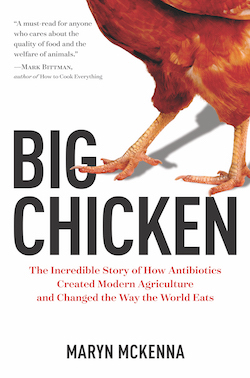SEJournal Online is the digital news magazine of the Society of Environmental Journalists. Learn more about SEJournal Online, including submission, subscription and advertising information.
BookShelf
“Big Chicken: The Incredible Story of How Antibiotics Created Modern Agriculture and Changed the Way the World Eats”
By Maryn McKenna
National Geographic, $27.00
Reviewed by Jennifer Weeks
If you visit a large commercial poultry farm, you will notice several things right away about the birds.
First, they are all white. Second, they have big, bulky breast muscles that can make them top-heavy – like “an olive propped up on two toothpicks,” as Maryn McKenna writes in “Big Chicken: The Incredible Story of How Antibiotics Created Modern Agriculture and Changed the Way the World Eats,” an absorbing investigation of the links between large-scale use of antibiotics and the evolution of industrial poultry farming.
 |
Both features reflect the fact that most chicken raised in the United States has been engineered to produce meat cheaply and quickly.
Farmers raise hybridized white birds because meat from light-feathered chickens looks cleaner after it has been defeathered than meat from dark-feathered birds. And they have been raised to put on weight mainly in their breasts because U.S. consumers prefer white meat.
McKenna’s larger point is that — without massive use of antibiotics — we would not have huge concentrated animal feeding operations, better known as CAFOs, with thousands of standardized chickens per building and harmful environmental impacts that some SEJ members have covered.
“Farmers began using the drugs because antibiotics allowed animals to convert feed to tasty muscle more efficiently; when that result made it more irresistible to pack more livestock into barns, antibiotics protected animals against the likelihood of disease,” she writes.
Eventually, they also made chicken “the meat most likely to transmit foodborne illness, and also antibiotic resistance, the greatest slow-brewing health crisis of our time.”
McKenna is an award-winning author of two other books on antibiotic resistance and on the Centers for Disease Control and Prevention’s Epidemic Intelligence Service, which investigates disease outbreaks, including foodborne illness.
“Big Chicken” leverages her expertise to show how the U.S. poultry industry has evolved, and its role in the spread of resistant infections. It also describes how the Food and Drug Administration finally adopted new policies that require farmers to stop using antibiotics as growth promoters, and work with veterinarians to manage other uses — reforms that just became final at the beginning of 2017.
McKenna describes how agricultural researchers fell in love with antibiotics after World War II, when they seemed like miracle drugs. Most experts embraced the idea of antibiotics as growth promoters, without really understanding how the drugs worked.
Poultry farming moved out of back yards
into sheds as long as football fields that produce odors,
toxic air emissions and massive quantities of manure
that have polluted U.S. rivers and bays.
She traces the evolution of the commercial chicken industry through innovations such as turning little-used parts into chicken patties and nuggets. Public policy also was a factor: In 1977, the Senate Select Committee on Nutrition approved the first U.S. dietary guidelines, which recommended eating less saturated fat. That triggered a large-scale shift from beef to chicken.
The heart of the book explains how antibiotic-resistant infections started appearing in the 1950s, and how investigators gradually linked many of those episodes over the next several decades to animal agriculture.
In parallel, it explains how poultry farming moved out of back yards into sheds as long as football fields. These “houses” produce odors, toxic air emissions and massive quantities of manure that have polluted U.S. rivers and bays. They also spread resistant bacteria into the environment and into processing plants.
It’s not all bad news. McKenna explores farms in Europe that raise poultry without antibiotics, or use them only under strict limits, and produce better chicken.
And she traces a shift in the U.S. poultry industry over the past decade, with big producers such as Perdue and companies such as McDonald’s and Costco deciding to go antibiotic-free, or at least end their use as growth promoters. The FDA’s guidance, finalized in 2013, provided an important push.
Some large and medium producers are showing that “chickens can be raised indoors in an intensive manner, with minimal or no antibiotics … if the birds are given vaccine and other supplements, and space, and a chance to exercise, and light,” McKenna writes. “To remove antibiotics is not to ruin intensive agriculture; it is to bring intensive agriculture to a place where animal welfare becomes part of the business model.”
“Big Chicken” is an eye-opening read for anyone who wants to understand that transition and the mistakes that preceded it.
Jennifer Weeks is environment and energy editor at The Conversation U.S., based in Boston, and is a former SEJ board member.
* From the weekly news magazine SEJournal Online, Vol. 2, No. 42. Content from each new issue of SEJournal Online is available to the public via the SEJournal Online main page. Subscribe to the e-newsletter here. And see past issues of the SEJournal archived here.













 Advertisement
Advertisement 



